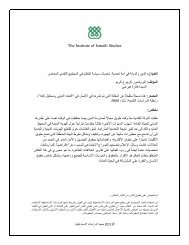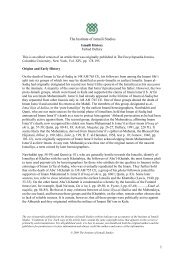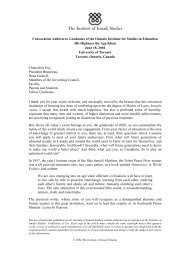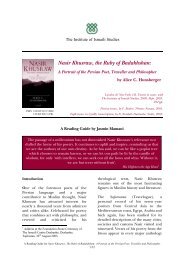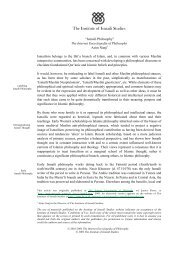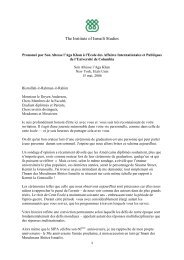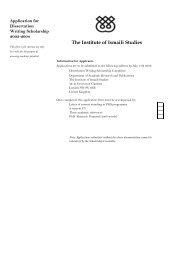BM-IIS Conference Pack.qxp - The Institute of Ismaili Studies
BM-IIS Conference Pack.qxp - The Institute of Ismaili Studies
BM-IIS Conference Pack.qxp - The Institute of Ismaili Studies
You also want an ePaper? Increase the reach of your titles
YUMPU automatically turns print PDFs into web optimized ePapers that Google loves.
<strong>BM</strong>-<strong>IIS</strong> <strong>Conference</strong> <strong>Pack</strong>.<strong>qxp</strong> 20/03/2009 14:13 Page 20<br />
PEDRAM KHOSRONEJAD<br />
Chair for the panel, “Ritual Expressions in Shi‘i Contexts”<br />
Pedram Khosronejad is currently the Goli Rais Larizadeh Fellow <strong>of</strong> the Iran Heritage<br />
Foundation for Iranian <strong>Studies</strong> at the University <strong>of</strong> St Andrews’ Department <strong>of</strong> Social<br />
Anthropology. His PhD thesis examined religious material culture, its visual<br />
representation and the techniques <strong>of</strong> its creation amongst the pastoral nomads <strong>of</strong> Iran.<br />
For his research he was particularly interested in how religious and oral beliefs<br />
regarding death and dying lead to the creation <strong>of</strong> mortuary material culture and<br />
mortuary visual representation. More recently he has been researching the themes <strong>of</strong><br />
death and dying vis-à-vis war and martyrdom and their visual representations in<br />
documentary film and photography in Iran and the larger Muslim world, particularly in<br />
Shi‘i communities. He is the editor <strong>of</strong> three forthcoming titles: Les Lions en pierres chez<br />
les Nomades Bakhtiari (Leuven); <strong>The</strong> Art and Material Culture <strong>of</strong> Iranian Shiism (<strong>Conference</strong><br />
proceedings, London); and Unburied Memories: Martyrs Grave Photographs and Funerary<br />
Memorial Objects, as guest editor for the Journal <strong>of</strong> Visual Anthropology. His recent articles<br />
include: “Where is the Anthropology <strong>of</strong> Iran After 70 Years?”, Anthropology News 48/2<br />
(Feb 2007); “<strong>The</strong> Anthropology <strong>of</strong> Islamic Shiite Art and Material Culture”, Anthropology<br />
News 47/6 (Sept 2006); and “<strong>The</strong> Shahnameh in Bakhtiari Nomadic Society:<br />
Anthropological Aspects <strong>of</strong> Heroes and Heroism”, Iran XLIV (2006): 321-26.<br />
MARA LEICHTMAN<br />
“<strong>The</strong> Africanization <strong>of</strong> ‘Ashura in Senegal”<br />
Paper Abstracts and Academic Biographies<br />
<strong>The</strong> first ten days <strong>of</strong> the month <strong>of</strong> Muharram, during which the martyrdom <strong>of</strong> Imam<br />
Husayn, his family, and army is commemorated, is <strong>of</strong>ten taken as an essential cultural<br />
paradigm for Shi‘i Islam, both by academics and by Shi‘i Muslims themselves. Scholars<br />
have written extensively about ‘Ashura practices in Iran, Iraq, Lebanon, Pakistan, and<br />
elsewhere, where the mourning period is marked by reenacting the story <strong>of</strong> the battle<br />
<strong>of</strong> Karbala, including self-flagellation. Over the past two years, Senegalese converts to<br />
Shi‘i Islam have begun to commemorate ‘Ashura in their own way. <strong>The</strong>y insist that these<br />
Arab or Persian practices are not essential to Shi‘i Islam, stressing in contrast their<br />
Senegalese or African Shi‘i identity. Converts in Dakar have organised public debates<br />
which cater to a Senegalese Sunni Muslim audience in a mixture <strong>of</strong> Wol<strong>of</strong>, Arabic, and<br />
French languages. In Senegal, ‘Ashura overlaps with Tamkharit, a festive occasion with<br />
pre-Islamic origins where members <strong>of</strong> the Sufi orders feast on couscous and girls dress<br />
as boys and boys as girls. Some believe this holiday celebrates the Muslim New Year,<br />
although it falls on the 10th and not the 1st <strong>of</strong> Muharram, and is linked to other<br />
Qur’anic events. Senegalese Shi‘a hope that through educating the Senegalese<br />
population about ‘Ashura they will sensitize them to the sadness <strong>of</strong> this date and avoid<br />
conflict. <strong>Conference</strong>s and television and radio appearances discuss whether ‘Ashura is a<br />
celebration or a day <strong>of</strong> mourning and play up the closeness that African Sufis also feel<br />
toward the family <strong>of</strong> the Prophet.<br />
Mara A. Leichtman is Assistant Pr<strong>of</strong>essor <strong>of</strong> Anthropology and Muslim <strong>Studies</strong> at<br />
Michigan State University. During the 2007-2008 academic year she was a visiting fellow<br />
at the Zentrum Moderner Orient/Centre for Modern Oriental <strong>Studies</strong> in Berlin, Germany,<br />
and the International <strong>Institute</strong> for the Study <strong>of</strong> Islam in the Modern World (ISIM) in<br />
Leiden, the Netherlands. She has been conducting research and teaching in Senegal<br />
since 2000. Her research is multi-sited, including fieldwork in Lebanon, France, and<br />
England examining ties between Senegal and Lebanon, and linkages with transnational<br />
Shi‘i institutions headquartered in Europe. She has published various articles and book<br />
chapters on Shi‘i Islam. She recently published a co-edited volume with Mamadou<br />
Diouf titled New Perspectives on Islam in Senegal: Conversion, Migration, Wealth, Power and<br />
Femininity (New York 2009). She is also working on a book manuscript preliminarily<br />
entitled Becoming Shi‘a in Africa: Lebanese Migrants and Senegalese Converts.



